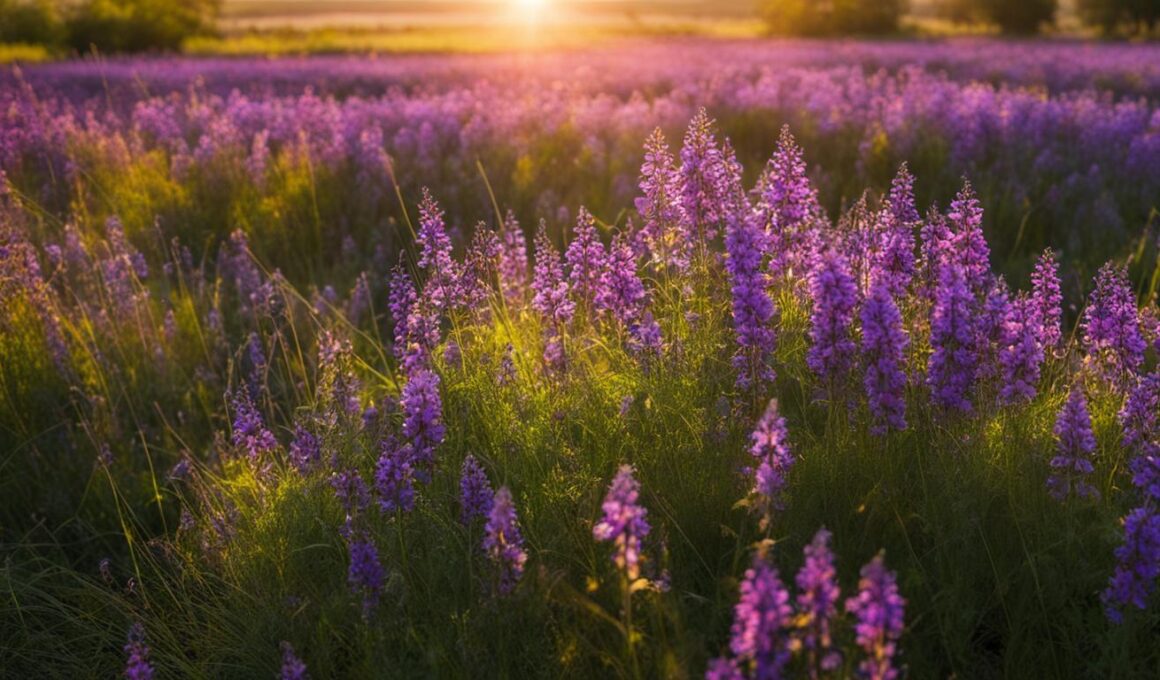Texas is home to a wide variety of stunning purple wildflowers that add a vibrant touch to the landscape. From the iconic bluebonnets to lesser-known species, these purple blooms are a sight to behold. Whether you’re looking to explore the wildflower season in the Texas Hill Country or grow purple flowers in your own yard, this guide will provide you with all the information you need.
When it comes to Texas wildflowers, vibrant purple blooms can be found throughout the state. These eye-catching flowers not only beautify the surroundings but also attract pollinators, bringing life to your garden or the great outdoors. No matter where you are in Texas, you can easily discover an abundance of purple wildflowers.
In this comprehensive guide, we’ll explore the different types of purple wildflowers found in Texas, discuss tips and techniques for planting and growing them, and provide insight into the unique characteristics of each species. Whether you’re a nature enthusiast, a gardening aficionado, or simply appreciate the beauty of flowers, this guide is for you.
So, let’s delve into the world of purple flowers in Texas and discover the mesmerizing botanical wonders that await!
Types of Purple Wildflowers in Texas
Texas is known for its vibrant wildflowers, and purple blooms are a particular highlight. While bluebonnets and Indian paintbrushes may be the most famous, there are numerous other types of purple wildflowers that thrive in the Lone Star State. These stunning flowers add a touch of color and beauty to the Texas landscape. Let’s explore some of the most captivating species:
1. Beach False Foxglove
The Beach False Foxglove showcases delicate purple flowers with yellow centers and distinctive lobed leaves. This perennial plant is a perfect addition to coastal gardens and thrives in sandy soils.
2. Downy Indian Paintbrush
Featuring purple flower heads atop long green stems, the Downy Indian Paintbrush is an eye-catching wildflower that adds a pop of color to meadows and prairies. It is often found alongside other wildflowers, creating a stunning floral display.
3. Giant Spiderwort
The Giant Spiderwort is a native perennial with beautiful purple flowers that bloom in clusters. Its long, arching leaves add an elegant touch to gardens and natural areas.
4. Goldeneye Phlox
The Goldeneye Phlox flaunts clusters of vibrant purple flowers with yellow centers, creating a striking contrast. This wildflower is well-suited for rock gardens and sunny borders.
5. Lindheimer’s Milkvetch
Lindheimer’s Milkvetch is a beloved Texas wildflower that boasts clusters of small, purple pea-like flowers. It is known for its ability to tolerate various growing conditions, making it a versatile choice for gardens and landscapes.
6. Purple Coneflowers
Purple Coneflowers, also known as Echinacea, are iconic wildflowers with vibrant purple petals and a cone-shaped center. They attract butterflies and bees, making them a favorite among pollinator gardens.
7. Purple Gerardia
The Purple Gerardia is a stunning perennial with upright stems and beautiful purple, tubular flowers. It thrives in full sun and well-drained soils, making it an ideal choice for xeriscapes and pollinator-friendly gardens.
8. Purple Milkweed
Purple Milkweed is a native plant that showcases clusters of purple flowers atop tall stems. It is a favorite among monarch butterflies, as it serves as a valuable food source for their caterpillars.
9. Prairie Verbena
The Prairie Verbena is a drought-tolerant perennial with small, dainty purple flowers. It is a good choice for adding a pop of color to rock gardens and sandy areas.
10. Winecup
With its showy deep purple flowers, the Winecup is a popular Texas wildflower that thrives in sunny spots. Its cup-shaped blooms make a stunning statement in garden beds and borders.
11. Woolly Locoweed
Woolly Locoweed is a low-growing perennial with fuzzy silver-gray leaves and clusters of purple flowers. It is well-suited for dry, rocky slopes and adds a unique texture to landscapes.
Are There Any Purple Flowers in Texas That Resemble Roses?
Yes, there are several types of purple flowers that look like roses which can be found in Texas, such as the Purple coneflower (Echinacea purpurea) and the Purple passionflower (Passiflora incarnata). Both of these flowers have a similar appearance to roses and can add a touch of elegance to any garden.
Planting and Growing Wildflowers in Texas
If you’re interested in growing your own purple wildflowers in Texas, there are several options to consider. You can plant them in your grass, in pots, or in a dedicated garden. Each method requires different steps and considerations.
When planting wildflowers in your grass, make sure to prepare the soil properly by removing any existing grass or weeds. Loosen the soil and mix in organic matter to improve drainage and fertility. Scatter the wildflower seeds evenly and lightly cover them with soil. Water the area regularly but avoid overwatering.
For growing wildflowers in pots, choose a suitable container with good drainage. Fill it with well-draining potting soil and scatter the seeds over the surface. Lightly press the seeds into the soil and water gently. Place the pots in a sunny location and water regularly to keep the soil moist.
If you prefer planting wildflowers in a dedicated garden, prepare the soil by removing weeds and adding compost or organic matter. Dig shallow trenches and scatter the seeds evenly. Lightly cover the seeds with soil and water gently. Keep the soil consistently moist until the seeds germinate.
The germination and growth period of wildflowers can vary depending on the species. Some wildflowers may take a few weeks to germinate, while others may take several months. It’s important to be patient and provide the necessary care and attention to your growing wildflowers.
By following the right planting and care techniques, you can enjoy the beauty of Texas wildflowers in your own backyard. Whether they are planted in grass, pots, or gardens, these vibrant blooms will bring a touch of nature’s beauty to your outdoor space.









